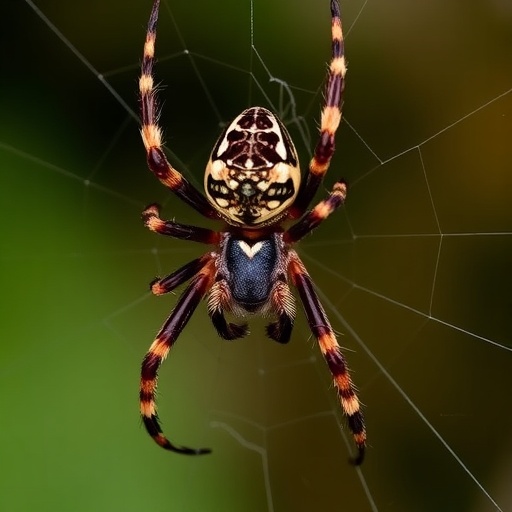In a groundbreaking study, researchers have delved deep into the fascinating world of brown widow spiders, revealing intriguing insights into their mating behaviors and strategies. This study is crucial as it challenges long-held beliefs about sexual selection and reproductive tactics in arachnids. The brown widow’s deceptive structures and complex mating processes have become a focal point for evolutionary biologists seeking to understand how species adapt their reproductive strategies to enhance survival and reproductive success.
The study examines alternative mating tactics utilized by male brown widow spiders and questions the widely accepted notion that male self-sacrifice during mating inherently benefits the copulatory mechanism and reproductive success. Traditional views suggest that male spiders, by willingly sacrificing their lives during or shortly after mating, increase the chances of their sperm being used while simultaneously providing nutrition to the female, thus increasing the survival of their offspring. However, this new research pushes those boundaries, suggesting that the benefits of male self-sacrifice may not be as clear-cut as previously thought.
Through meticulous observation and experimentation, the researchers carefully analyzed the mating processes of urban populations of brown widow spiders, particularly focusing on variations in male behavior before and during copulation. This observational data was crucial in understanding the nuances of spider behavior, offering an unprecedented look into how these incredible creatures navigate their mating strategies. The findings provide insights not only into the mating practices of brown widow spiders but also indicate potential implications for understanding sexual selection across various species.
Interestingly, the research identified two distinct mating tactics among male brown widow spiders: one where males engage in self-sacrifice by allowing themselves to be consumed by the female, and another where males evade this fate entirely. Surprisingly, the study discovered that both tactics yield comparable success rates regarding fertilization. This revelation has significant implications, suggesting that male brown widows may possess greater flexibility in their mating strategies than previously acknowledged, allowing for adaptations based on environmental conditions or population dynamics.
Moreover, the intricate courtship behaviors of these spiders were scrutinized. The males employed specific signaling mechanisms and behaviors to entice females, highlighting a complex interplay of attraction, aggression, and reproductive strategies. This aspect of the research aligns with broader theories of sexual selection, demonstrating how males evolve dynamic courting behaviors that enhance their desirability and mating opportunities. The careful balance of risk and reward during courtship is exemplified through these interactions, indicating that sexual selection can drive behavioral differences even within closely related species.
The research also raises important questions regarding the evolutionary implications of such alternative mating strategies. If female brown widows are receptive to mates that exhibit alternative behaviors, it can lead to significant shifts in reproductive success across generations. This flexibility may enhance genetic diversity within the population, a vital factor in adapting to environmental changes, thereby affecting overall species resilience.
In addition, the study underscores the critical role of environmental factors in shaping reproductive strategies. The urban settings where these brown widows dwell present unique challenges and opportunities that could influence mating tactics. Exposure to varied threats, availability of resources, and competition dynamics in urban habitats necessitate adaptive behaviors for survival. Understanding how such environmental cues affect mating decisions offers a poignant example of natural selection in action.
This exploration of brown widow spider mating tactics opens a myriad of avenues for further research. As scientists continue to unravel the complexities of arachnid reproductive strategies, new hypotheses and experiments can be formulated to explore this fascinating area of biology further. The implications of such studies are far-reaching, as they not only add to our knowledge of sexual selection and mating behaviors in spiders but set a precedent for examining similar adaptations in other taxa.
As scientists reveal more about the brown widow’s mating strategies, the broader ecological and evolutionary significance of their findings contributes to our understanding of life on Earth. The success and adaptability of these spiders may serve as critical indicators of environmental health and the impacts of urbanization on local ecosystems. This research challenges us to rethink our understanding of reproduction, showcasing the complex interplay between behavior, environmental factors, and evolutionary strategy.
In conclusion, the study of brown widow spider mating tactics represents a significant advancement in our comprehension of sexual selection and reproductive strategies in the animal kingdom. By questioning established ideas about male self-sacrifice and revealing the viability of alternative mating tactics, this research offers a fresh perspective on how species navigate survival and reproductive success. It reinforces the idea that biological interactions are not static but dynamic and continually shaped by a range of internal and external influences.
The findings serve as a reminder that nature is full of surprises, holding wisdom that often challenges our finest scientific theories. As researchers delve deeper into the lives of these remarkable creatures, we are reminded of the intricate tapestry of life that surrounds us, continually shaped by evolution and adaptation.
Research into the behavior of brown widow spiders not only deepens our appreciation for these intriguing arachnids but also reflects the broader challenges faced by many species in today’s rapidly changing world. The wisdom unveiled within this study ultimately encourages us to consider the complex social and ecological networks that define life on Earth, shedding light on the delicate balance required for survival in the face of ever-evolving environmental conditions.
Subject of Research: Alternative mating tactics in brown widow spiders
Article Title: Alternative mating tactics in brown widow spiders: mating with or without male self-sacrifice does not affect the copulatory mechanism.
Article References:
Sentenská, L., Poy, D., Andrade, M.C.B. et al. Alternative mating tactics in brown widow spiders: mating with or without male self-sacrifice does not affect the copulatory mechanism.
Front Zool 22, 6 (2025). https://doi.org/10.1186/s12983-025-00560-8
Image Credits: AI Generated
DOI: 10.1186/s12983-025-00560-8
Keywords: brown widow spiders, mating tactics, male self-sacrifice, sexual selection, reproductive strategies.




